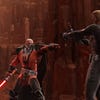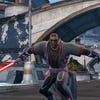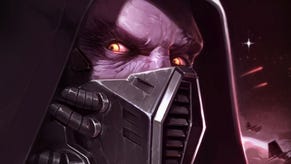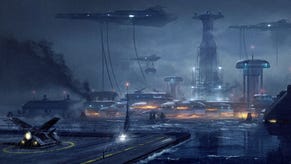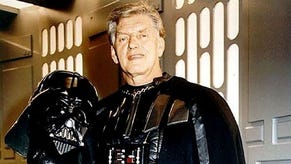Star Wars: The Old Republic
Leia upon Leia.
Happy Hour has yet to start, no-one's making the first move and there's unlikely to be much in the way of cross-species intercourse after the stagger home from the kebab shop. The interactions feel a little cold and detached, as though the participants aren't really sure where they are and what they're meant to be doing here.
And while it's fascinating to tease a character out of the main storyline and into your team as a companion, once at your side, they trail blindly behind you like an almost-mute quest NPC. Attempt to talk to them before their personal story opens up and you'll receive a rote "I'm too busy to talk" response, repeated over and over. Given the well-publicised depth of voice-acting in the game, it seems a little odd that an allowance hasn't been made for at least some unique commentary to be provided as the story unfolds. Perhaps we'll see some further development here for the final game.
As it stands, the cover system so crucial to the Imperial Agent's performance is also a little buggy. An icon may appear above an object, but you won't always take shelter behind it. When the system works, it works spectacularly, allowing you to take a more strategic approach with your team, as sniper and covering-fire options open up. When it fails, it fails rather badly, leaving the player feeling ham-fisted and vulnerable.
These issues can all be fixed of course, and to focus too closely on them is to ignore the many remarkable achievements BioWare has already made. The holo-communicator connecting you to your quest-givers not only provides welcome relief from the usual to-and-fro, but also brings another flutter to the Star Wars heart. As befits a game with so much dedication to the finer details of the carefully crafted universe, its ice-cold blue projections flicker with reassuring familiarity.
The health recovery system is a refreshing change of pace to the usual fare where you watch your characters sit on its backside, drinking itself to a lonely death. When your Imperial Agent pauses to gather strength in The Old Republic, a droid gently floats and bobs in front of you, projecting a holoscreen on which your character idly taps away. Perhaps she's updating her Facebook status: "Nearly died on Hutta. LULZ."
Kaas City contrasts sharply with the murkier Huttan planet and it's at this point that we get a feel for the breadth of environments rendered in the game. Where gloomy vegetation and mournful animal calls fill the swamplands of Hutta, Kaas City is a vertiginous sprawl of deep chasms that leer beneath you while mechanical spires soar overhead. City travel is accomplished in sleek hovering taxis and interiors are filled with holographic projections of planetary statistics. It is fantastically, gloriously Star Wars in both look and feel.
Our first taste of the traditional instanced MMO content takes place in the Brentaal Star where a rogue general lies guarded. We're able to complete this section without healing support and with purely damage-focused players.
It's a simple affair, focused on dispatching waves of enemies as we progress through the ship corridors. BioWare is tight-lipped on whether this style of grouping is indicative of the overall party component of the game or merely an example of an easier early instance. While the sight of ferocious battles being waged outside the ship windows certainly makes the heart sing, it may sink after running the rather repetitive gauntlets of the instance several times.
So while there's a more timid evolution behind some of the player-versus-environment elements of The Old Republic – albeit one heavily influenced by the rich progress made in Mass Effect and KOTOR – the game's most intriguing contribution to a typically cautious genre is to bring an inherent sense of community to the player-versus-player component of the game, the Warzones.
Post-match, the familiar battlefield report gives details of damage done, healing done, healing received and the usual statistical information, but there's a twist. At the end of each match, every player receives the option to vote for the person they feel made the most significant contribution to the team.

